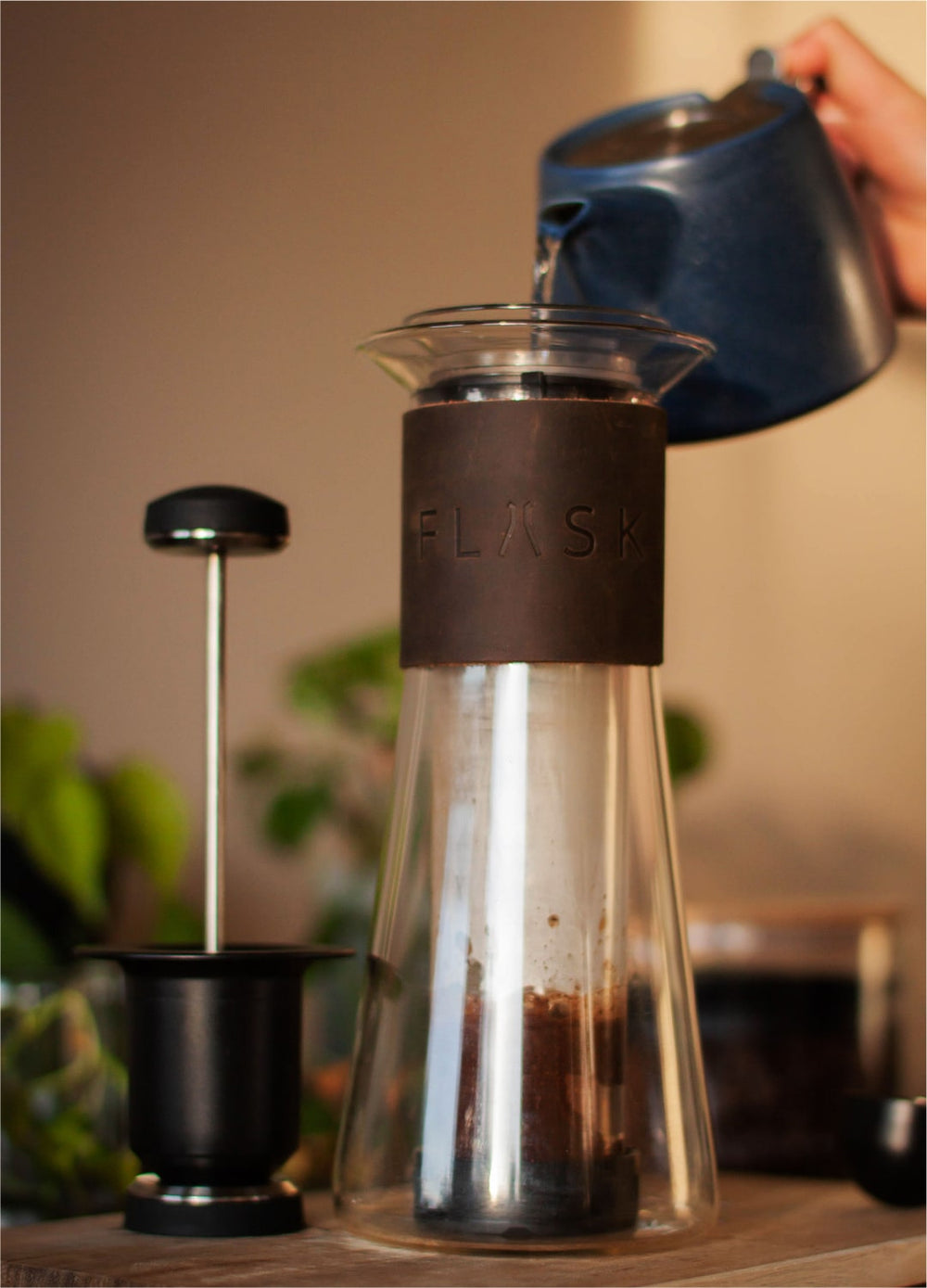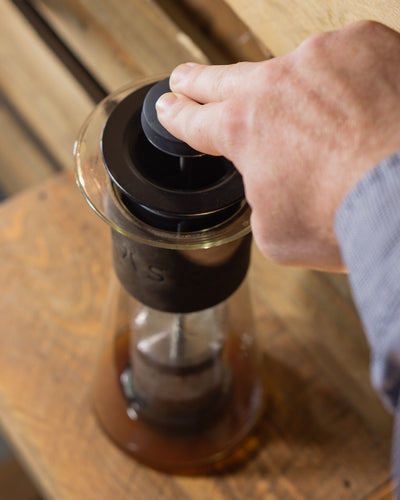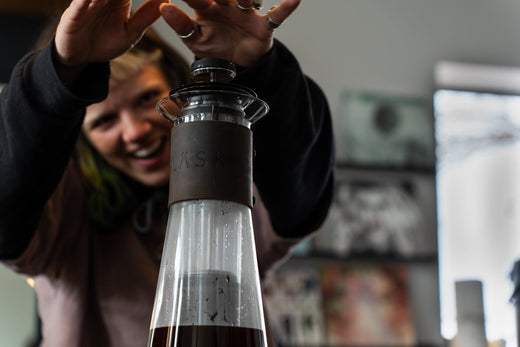Ever watched hot water hit fresh coffee grounds and seen them bubble up like a tiny volcano? That's blooming, and learning how to bloom coffee properly can transform your morning brew from good to spectacular.
It's one of those coffee tricks that sounds fancy but is actually super simple to master. Whether you're a coffee newbie or a brewing veteran, understanding this quick but crucial step will help you unlock flavors you didn't even know were hiding in your beans.
What is blooming coffee?
What does it mean to bloom coffee? Blooming is the process of pouring a small amount of hot water over fresh grounds and letting them degass for 30-60 seconds before the main brew. This eleases trapped CO2 from the beans, allowing water to better extract the coffee's flavor during brewing.
Think of blooming like waking up your coffee grounds. When coffee beans are roasted, they trap carbon dioxide inside. This gas needs to escape before water can properly interact with the grounds - kind of like trying to soak a really puffy jacket that's full of air. You need to let that air out first! When hot water hits the grounds, you'll see them swell and bubble as the CO2 escapes, creating that characteristic "bloom" that gives this step its name.
A press coffee maker, like Flask, makes it easy to spot this freshness indicator in action through its clear brewing chamber. The fresher your coffee, the more dramatic this reaction will be. Recently roasted beans have more trapped CO2, so they'll bubble up more intensely than older beans. That's why watching your coffee bloom can actually tell you something about how fresh your beans are - and with Flask's unique design, you get a front-row seat to this coffee theater. Pretty neat, right?
Does blooming coffee make a difference?
Yes, blooming coffee grounds does make a noticeable difference in your cup's flavor. When you skip the bloom, trapped CO2 creates channels in your grounds and blocks water from evenly extracting all those delicious coffee compounds. What's the result? Sour, uneven, and less flavorful coffee.
Not convinced? Try brewing two cups side by side - one with a proper bloom and one without. You'll taste the difference immediately. A properly bloomed coffee has a smoother, more balanced flavor profile with less acidity and more of those subtle tasting notes you paid for. It's like giving your coffee the chance to take a deep breath before diving into the pool.
The difference is especially noticeable with Flask's brewing system, where the unique double-wall design helps maintain the perfect blooming temperature. This consistent heat means you're getting optimal CO2 release during the bloom phase, setting you up for a perfectly extracted cup every time.
What does blooming coffee do?
So, why bloom coffee? Letting coffee bloom serves three crucial purposes: it releases trapped CO2 gas that would otherwise create bitter flavors, it helps the grounds saturate evenly, and it ensures proper extraction of all the flavor compounds. Think of it as your coffee's warm-up routine before the main event.
This step is particularly important because trapped CO2 acts as a barrier between your coffee grounds and water. When you skip blooming, that gas forcefully escapes during brewing, creating uneven pockets and channels in your coffee bed. Water, being lazy like most of us, will take the path of least resistance through these channels, leading to under-extraction in some areas and over-extraction in others.
But when you give your coffee time to bloom, you're setting the stage for even extraction. The initial hot water triggers a controlled release of CO2, while also beginning to soften and prepare the grounds. Each particle gets primed for the perfect extraction that follows. It's like giving your coffee a chance to stretch before asking it to perform - you'll get better results every time.
The process also reveals something about your coffee's freshness. Fresh coffee will bubble up dramatically during blooming as it releases more trapped CO2, while older coffee might show a milder reaction. That's why specialty coffee makers like Flask emphasize this step - it's not just about better flavor, it's about respecting the coffee's natural properties and getting the most out of quality beans.
How long to bloom coffee grounds
For optimal results, let your coffee grounds bloom for 30-45 seconds. The exact timing depends on how fresh your beans are - newer roasts need a bit more time to release their CO2. You'll want to use about twice as much water as coffee by weight for the bloom phase.
The pour over coffee bloom time can vary based on your brewing method and coffee age. With super fresh beans (roasted within the past few days), you might want to extend your bloom to a full minute as they contain more CO2. For older beans (2+ weeks from roasting), 30 seconds is usually plenty since they've already released much of their gas.
Here's a quick guide for how long to let coffee bloom based on brewing method:
- French Press (like Flask): 45 seconds
- Pour Over: 30-45 seconds
- Drip Methods: 30 seconds
- Immersion Brewing: 45-60 seconds
How to bloom coffee
Start with freshly ground coffee and water just off the boil. Pour about twice the weight of your grounds in water, making sure all grounds are evenly saturated. Wait 30-45 seconds while the coffee bubbles and expands, then continue with your regular brewing process. That's all there is to it!
Learning how to bloom pour over coffee is straightforward, but there are a few key things that'll help you nail it every time:
- Grind your coffee right before brewing for maximum CO2 content
- Make sure all grounds are saturated - dry spots mean uneven extraction
- Keep your pour steady and controlled to avoid disturbing the coffee bed
- Let the bubbling guide you - if it's still very active after 30 seconds, give it a bit more time
- Practice makes perfect - your technique will improve with each brew
How much water to bloom coffee?
Here's your golden rule: use twice as much water as coffee for your bloom. If you're brewing with 30 grams of coffee, hit it with 60 grams of water. Simple math, killer results.
The 2:1 ratio isn't just some random number coffee nerds made up - it's the sweet spot for proper saturation. Too little water and you'll get dry spots, leaving some grounds sleeping on the job. Too much water and you'll flood the grounds, diluting that precious first extraction and potentially cooling things down too much.
When using the Flask brewer, you can easily monitor this through the clear chamber. You want to see your grounds evenly saturated and bubbling away, not swimming in a coffee pool or looking parched. The double chamber design helps maintain temperature during this crucial phase, so you don't have to worry about heat loss while you're getting the ratio just right.
Key takeaways on coffee blooming
Coffee blooming (essentially a quickened coffee degassing, a controlled way to accelerate the degassing process during brewing) might sound like fancy barista talk.
But it's actually the most crucial step when learning how to use a pour over coffee maker or any brewing method.
It's that simple but magical pause at the start of your brew that transforms a decent cup into something spectacular. Think of it as giving your coffee a proper warm-up - just a few extra seconds that make all the difference between a good cup and a great one
Remember these coffee blooming basics:
- Always use freshly ground coffee for the best bloom
- Give it 30-45 seconds - no need to overthink the timing
- Use twice as much water as coffee for the bloom
- Watch for the bubbles to slow down before continuing your brew
- The fresher your beans, the more dramatic the bloom will be
Whether you're using Flask's sleek brewing system or your trusty home setup, blooming is that little bit of coffee magic that helps unlock the full potential of your beans. And isn't that what great coffee is all about? Taking a few mindful moments in your brewing routine to coax out those amazing flavors hiding in your grounds.
Next time someone asks why you're waiting before finishing your pour, you can smile knowingly - you're not just making coffee, you're crafting a properly bloomed, perfectly extracted cup of joe. And trust us, your taste buds will thank you for it.




